Odaka Cultural Properties
1. Daihisan no Sekibutsu (Daihisan Stone Buddhas)
Type: National designated historic site
Date Designated: July 8th, 1930
Location: Odaka-ku, Izumisawa, Yakushimae
Google Maps: Daihisan no Sekibutsu
Owner: Jitokuji Temple

The stone Buddha group in Izumisawa consists of three sets of Buddhas—the Yakushido Buddhas, the Amidado Buddha, and the Kannondo Buddha. They are known as the “Daihisan no Sekibutsu,” or “Daihisan Stone Buddhas.” Together with Usuki in Oita Prefecture and Otani in Tochigi Prefecture, this collection of Buddhas are a part of a bigger collection called, “Magaibutsu,” or “Japan’s Three Great Buddhas.”
The best-preserved Yakushido Stone Buddhas are a part of six three-dimensional, line-engraved representations of Buddha in the cavern about 15 meters long. They stand at 2 to 3 meters in height, with parts of their vermillion and yellow colors remaining. Standing in front of them, you can feel wrapped up in their presence. To the left of the Yakushido Stone Buddha is the Amidado Stone Buddha, which only a little of its impression remains.
The Kannondo Stone Buddha is a large Senju Kannon located a little deeper to the northeast of the Yakushido Stone Buddha. Although many parts have collapsed, it is about 9 meters high and is one of the largest stone Buddhas in the country. The date and creator of these stone statues are unclear, but they are presumed to be in the early Heian period due to the way they are carved. As giant, ancient relics with great artistic value, these stone Buddhas were nationally designated as a historic site for their uniqueness.

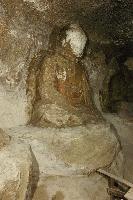
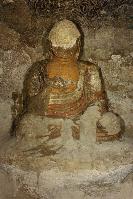
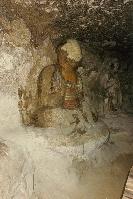
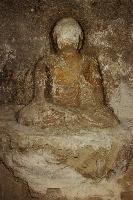
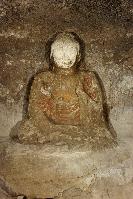
2. Urajiri Kaizuka (Urajiri Shell Mound)
Type: National designated historic site
Date Designated: January 26th, 2006
Location: Odaka-ku, Urajiri, Minamidai
Google Maps: Urajiri Kaizuka
Owner: Minamisoma City
Dimensions: About 70,000 square meters.
Urajiri Shell Mound is a large heap of land and the site of a large community covering about 70,000 square meters, dated to have existed about 5,700 to 3,000 years ago (early-to-late Jomon period).
A kaizuka, or shell mound, is a pile of discarded leftovers, such as shellfish, from meals. Shell mounds are considered to be particularly important areas of an archeological site because the bones of decomposed fish and animals can be found in such sites, even after thousands of years have passed.
Urajiri Shell Mound has been found to be particularly large, with a depth of over 1.8 meters. There are other shell mounds from several different ages at Urajiri Shell Mound, allowing researches to learn about shifts in the sea and how cooking has changed during the Jomon period. As such, Urajiri Shell Mound serves as a representation of Fukushima Prefecture during the Jomon Period.
You can view a cross-section of the Urajiri Shell Mound at the Minamisoma Museum.


Unearthed wild boar mandible and deer antler

Uncovered earthenware
3. Yokodaido Seitetsu Iseki (Yokodaido Ironworks Site)
Type: National designated historic site
Date Designated: February 27th, 2011
Location: Odaka-ku, Hansaki, Nishihara
Google Maps: Yokodaido Seitetsu Iseki
Owner: Minamisoma City
Dimensions: About 9,300 square meters

This is a ironmaking site located in Hansaki, Odaka, from the Nara and Heian periods (710-1185 CE). Minamisoma’s abundant supply of sand iron was used for a prosperous business of manufacturing iron. As one of the nation’s leading iron manufacturing areas during the Nara-Heian period, Minamisoma contributed greatly to state operations. This archeological site also contains a vertical furnace, a new technology at the time. This type of furnace was introduced to the area in the latter half of the Nara period and systematically arranged. Because of this, the area is valuable as a large-scale ironmaking archeological site and designated a national historic site.
4. Takashima-ke Jutaku Konkurito-zo, Mon Oyobi Hei (Takashima Estate’s Concrete Warehouse, Gate, and Fence)
Type: Nationally registered tangible cultural property
Date Designated: October 27th, 2017
Location: Odaka-ku, Kamimachi
Owner: Individual
Structure/Dimensions: Concrete warehouse, reinforced concrete storehouse, 2 stories, flat roof, building area roughly 37 square meters.
Gate: Brick, 2.8 meters
Fence: Brick, total length is 34 meters

The Takashima estate’s concrete warehouse was built in the early Showa period (1926-1989). Using state-of-the-art concrete construction technology at the time, it has the unusual characteristic of having the stairs, the terrace to the roof, and the handrail all three-dimensionally combined. The entrance is a Japanese-style storehouse with earthen walls,, the first floor is a warehouse, and the second floor is a storage room with a Western-style stucco plaster coating design. Japanese and Western styles are mixed, and elaborate plastering work can be seen everywhere. In addition, the watermarked red brick gate and fence stand in vivid contrast to the concrete warehouse, symbolizing the unique architectural culture of Odaka.
5. Daimyo Konrei Choudo Tou (Daimyo Wedding Set, Etc.)
Type: Prefecture designated important cultural property (crafts)
Date Designated: March 27th, 1987
Location: Odaka-ku, Odaka, Kamihirohata
Google Maps: Dokei Temple
Owner: Dokei Temple
Piece Count: 72 pieces
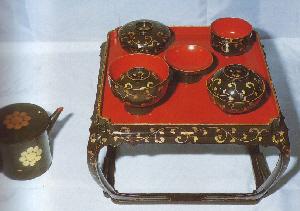
In the Soma Clan Sacred Hall, the lacquerware used for the wedding ceremony of the feudal lord, called the "Daimyo Wedding Set," is displayed. Made in the mid-to-late Edo period, the set was dedicated to the hall after the death of the wife of the 21st Soma feudal lord, Soma Masatane.
It is very rare to have all 72 items of the wedding set of a daimyo in such excellent condition and stored in this way.
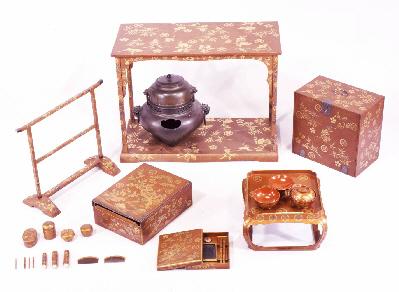
6. Daihisan Monjo (Daihisan Documents)
Type: Prefecture designated important cultural property (ancient cocument)
Date Designated: February 4th, 1955
Location: Odaka-ku, Odaka
Owner: Individual
This is an ancient document from the Kamakura and Namboku periods (1185-1392), related the Daihisan clan, a family in the Oshu Soma clan. The Daihisan clan was based in present-day Izumisawa (previously called Daihisan), from which they got their name.
This ancient document is one of the few documents related to the Oshu Soma clan in the Middle Ages.
7. Soma Nomaoi Gaku (Soma Nomaoi Framed Picture)
Type: Prefectural designated important tangible folk cultural assets
Date Designated: March 17th, 1959
Location: Odaka-ku, Odaka
Owner: Soma Odaka Shrine
This piece consists of three sides: an image of the Nomaoi parade, an image of chasing wild horses in a field, and the wild horse catching ceremony. It is presumed to have been made in the middle of the Edo period, around the 18th century, giving us a look into how Soma Nomaoi was celebrated at the time.
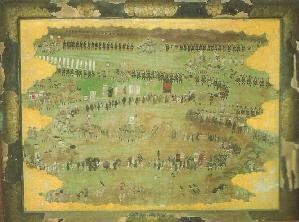
8. Ebisawa Inari Jinja Hounou Umajibiki Tairyouzu Wasenmokei (Ebisawa Inari Shrine Dedicated Picture of Dragnet Fishing and Japanese Ship Model)
Type: Prefecture designated important tangible folk cultural property
Date Designated: March 22nd, 1996
Location: Odaka-ku, Shimoebisawa
Google Maps: Ebisawa Inari Shrine
Owner: Ebisawa Inari Shrine
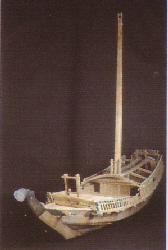
Ebisawa Inari Shrine has been cherished by the feudal lords for generations, and it is still known as a shrine where fishermen worship. This large dragnet fishing illustration dedicated in 1874 depicts the fishing village that seems to be on the beach of Urajiri as well as the image of dragnet fishing and fish trade.
In addition, two Japanese ship models are also on display. One was built in the Edo period, a model of a large barge before the appearance of mechanical ships, and the other is a model of a hand-paddled bonito boat, which was manufactured in the Meiji period.
It is said to be a valuable resource for learning the old shipbuilding techniques and ship structures that are difficult to understand now.

9. Odaka-jo Seki (Odaka Castle Ruins)
Type: Prefecture designated historic site
Date Designated: August 1st, 1958
Location: Odaka-ku, Old Odaka Castle (+others)
Owner: Soma Odaka Shrine (+others)
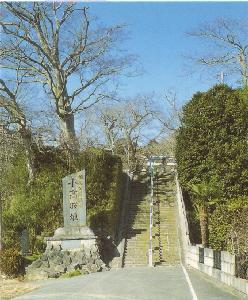
From the end of the Kamakura period to the beginning of the Edo period, Odaka Castle was the home of the Oshu Soma clan for about 280 years. It was also known as "Kobaisan Ukifune Castle," due to its appearance as a castle floating over the mountains covered in red-blossomed plum trees.
From the upheaval in the Northern and Southern dynasties to the conflict with the Date clan, it can be said without a doubt that the castle has survived through an era of conflict.
10. Daihisan no Osugi (Daihisan’s Giant Japanese Cedar)
Type: Prefecture designated natural monument
Date Designated: February 4th, 1955
Location: Odaka-ku, Izumisawa, Yakushimae
Google Maps: Yakushido Stone Buddhas
Owner: Jitokuji Temple
Dimensions: Circumference (at eye-level) – 8.4 meters Height – 45 meters

This tree is located in front of Yakushido Stone Buddhas in Daihisan. It is one of the largest trees in the prefecture, measuring 8.4 meters around the trunk at eye-level and 45 meters in height. It is estimated that the tree is around 1000 years old, and it is thought that the tree started to grow when the Yakushido Stone Buddha were created.
11. Murakami no Taue Odori (Murakami Rice Planting Dance)
Type: Prefecture designated important intangible folk cultural property
Designated Date: March 31st, 2015
Location: Odaka-ku, Murakami
Owner: Murakami Taue Odori Preservation Society

The Murakami Taue Odori is performed in front of the Kifune Shrine during the shrine’s spring festival in April. First there is a traditional clown known as the douke, followed by the Taue Odori. Dancers consist of the women, saotome, and the men, yahachi, who plant the seedlings in the field, as well as the nakauchi, who play handbells and small taiko drums. They are accompanied by flutes, framed taiko drums, and singers, all performing a folk song called "Soma Nagareyama".
The Murakami Taue Odori is extremely sophisticated dance, accompanied by a beautiful and technically polished song with many musical bars in the style of a traditional Japanese music genre of min-yo. It is a valuable performance piece through which one can understand the changes of Taue Odori in the prefecture.
12. Uraguri Futatsuki Funagata Kurinuki Sekken (Hollow Boat-Shape Stone Sarcophagus with a Lid)
Type: City designated tangible cultural property (archaeological material)
Date Designated: March 31st, 1966
Location: Odaka-ku, Izumisawa, Yakushimae
Google Maps: Yakushido Stone Buddhas
Owner: Minamisoma City
Dimensions: Length – 197cm Width – 70cm Depth – 31cm
This casket was discovered during construction at Minamidai in Urajiri. It is a casket made from a stone which was hollowed out and shaped like a boat. It was found in the main part of the burial mound and is currently stored in front of Daihisan Yakushido Stone Buddhas.
13. Fukabachi「Jomon-zenki Sekiyama Shikiheito」 (Deep Clay Pot (Parallel to Early Jomon Sekiyama Style))
Type: City designated tangible cultural property (archaeological material)
Date Designated: February 1st, 1968
Location: Odaka-ku, Kamiura
Owner: Minamisoma City
Dimensions: Diameter of the Opening – 21.7cm ・ Height (Restored) – 25.4cm
This is a piece of Jomon-era pottery made about 5,700 to 5,800 years ago, excavated from the Miyata Shell Mound in Kamiura. The pattern of the vase is from an intricate combination of various twisted ropes of clay. Even among the many pieces Jomon-era pottery, it possesses a beauty in its perfection.
14. Yabuuchi no Juuichi-men Kannon (Eleven-Faced Kannon in Yabuuchi)
Type: City designated tangible cultural property (sculpture)
Date Designated: September 20th, 1982
Location: Odaka-ku, Kamiura, Yabuuchi
Google Maps: Yabuuchi Juuichi-men Kannondo
Owner: Yabuuchi Kannondo Hall
Dimensions: Height – about 123cm

This statue is located in the Kannondo Hall in Yabuuchi, Kamiura. It is presumed to have been made during the Kamakura period (1185-1333) based on the technique used, and it is one of the oldest Buddha statues in Odaka. Although major repairs were made in the Edo period, the front has not changed significantly, and the original delicate expression can be seen in its cheeks.
15. Nakamurasaku no Monju Bosatsu Zazou (Nakamurasaku Manjushri Bodhisattva Statue)
Type: City designated tangible cultural property (sculpture)
Date Designated: February 14th, 1990
Location: Odaka-ku, Kamiura, Nakamurasaku
Owner: Kinshoji Temple
Dimensions: Height – about 21cm

Located in the Manjushri hall in Nakamurasaku, Kamiura, this statue is very small, about 21cm, and is thought to have been produced in the middle of the Edo period. It has a Buddhist image of a zelkova tree and the rare image of a celestial maiden with her hair hanging on her shoulders. The characteristics of this region can be well captured in the style of her clothes.
16. Nakamurasaku no Kokuzo Bosatsu Zazou (Nakamurasaku Akasagarbha Bodhisattva Statue)
Type: City designated tangible cultural property (sculpture)
Date Designated: February 14th, 1990
Location: Odaka-ku, Kamiura, Nakamurasaku
Owner: Kinshoji Temple
Dimensions: Height – about 22cm

This statue is located in the same hall as the Manjushri Bodhisattva Statue in Nakamurasaku. The height of the statue is about 22 cm, which is very small, and it is thought to have been created in the late 15th century during the Muromachi period due to its style. The lower portion, made in the style of this area, is quite weighty.
17. Shimoiwasaki no Shokannon Bosatsu Ryuzo (Shimoiwasaki Standing Holy Kannon Bodhisattva Statue)
Type: City designated tangible cultural property (sculpture)
Date Designated: February 14th, 1990
Location: Odaka-ku, Fukuoka, Shimoiwasaki
Owner: Kinshoji Temple
Dimensions: Height – about 154cm

Located in Shimoiwasaki, Fukuoka, Odaka-ku. This statue measures about 154 cm in height and is made of katsura wood. The production period is estimated to date back to the Kamakura period (1185-1333).
It is a beautiful Buddhist sculpture in which the masterful sculpting skills are captured in the strict expression on the long-nosed face and in detail of the clothes.
18. Hachiman Dai Bosatsu Ki (Hachiman Bodhisattva Flag)
Type: City designated tangible cultural property (historical material)
Date Designated: February 17th, 1999
Location: Odaka-ku, Odaka
Owner: Individual

At the beginning of the Kamakura era (1185-1333), Soma Morotsune, the founder of Oshu Soma clan, struck down Oshu Fujiwara of Hiraizumi clan, and was awarded the flag of Hachiman Bodhisattva by Minamoto No Yoritomo. The actual flag was burned, but a copy from the Edo period was left in Odaka.
Its origin is unique even among the many flags that are in the Soma region.
19. Nou Shozoku (Noh Costume)
Type: City designated tangible cultural property (craft)
Date Designated: February 17th, 1999
Location: Odaka-ku, Odaka
Owner: Individual
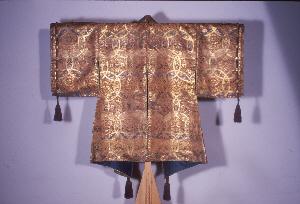
Noh was an indispensable form of entertainment among the samurai's official events during the Edo period (1603-1868), and Soma clan members frequently participated. This Noh costume possesses a feeling of dazzling luxury that conveys the prosperity of that time.
20. Densoma Masatsune Chakuyo Shirorasha Dijin-Baori (White Battle Surcoat Worn by Legendary Soma Masatsune)
Type: City designated tangible cultural property (craft)
Date Designated: February 17th, 1999
Location: Odaka-ku, Odaka
Owner: Individual
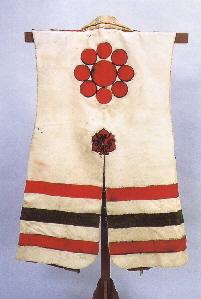
This is a battle surcoat that is said to have been worn by the 21st Soma feudal lord Soma Masatsune in the middle of the Edo period (1603-1868). The Soma clan’s family crest "Kuyoumon" is applied to the back, and the three-stripes of red and green are striking.
21. Asajisabi Asagiro Daimon (Pale Blue-Green Hemp Daimon)
Type: City designated tangible cultural property (craft)
Date Designated: February 17th, 1999
Location: Odaka-ku, Odaka
Owner: Individual
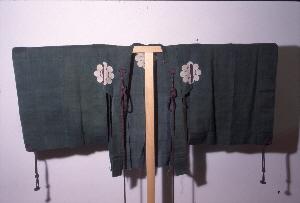
A daimon is a kimono worn with a long hakama (a divided skirt) and was restricted to the ranks of the samurai. This daimon is decorated with the family crest of the Soma clan, and can be said to be the formal clothing worn by the feudal lord. Due to the nature of daimon, few were made and very few remain today.
22. Nyobo Kaji Shozoku (Court Lady Fire Costume)
Type: City designated tangible cultural property (craft)
Date Designated: February 17th, 1999
Location: Odaka-ku, Odaka
Owner: Individual
This is a garment with a crow hat, a haori (a Japanese formal coat), a breastplate, and a hakama (a divided skirt). Based on the design of the coat of arms, it is thought to have belonged to the wife of the 24th Soma feudal lord Soma Morotane. It has been carefully crafted with consideration for fire prevention such as preventing sparks from entering the clothing.
The cloth is so delicate that cannot be restored and is now used for decoration. Fire costumes like this are extremely rare in Japan and are valuable as symbols of the daimyo culture.
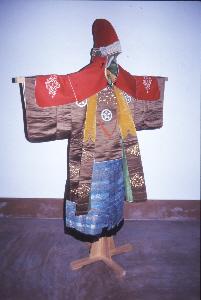
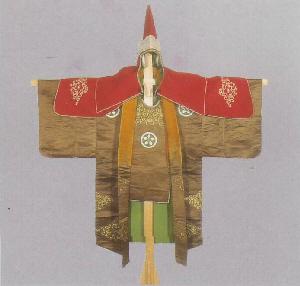
23. Nomagari no Kokufun (Wild Horse Hunting Report)
Type: City designated tangible cultural property (ancient document)
Date Designated: February 17th, 1999
Location: Odaka-ku, Odaka
Owner: Individual
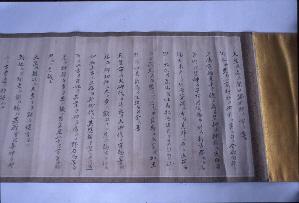
This is an ancient document proclaiming before the gods the Emperor's order to "catch all horses in Nomahara (wild horse field)," and proves the suspension of Soma Nomaoi in the early Meiji period.
24. Soma Kakeizu (Soma Clan Family Tree)
Type: City designated tangible cultural property (ancient document)
Date Designated: February 17th, 1999
Location: Odaka-ku, Odaka
Owner: Individual
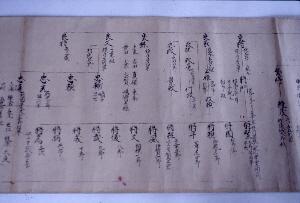
The Soma clan family tree is known as the prefecture's designated tangible cultural property at Kankiji Temple (Soma), but Odaka's is almost the same as that of Kankiji Temple, and is thought to have been made in the same time period.
25. Odaka-jo Atosai Shuukin Kohen (Odaka Castle Ruins Collection Gold Sea Bream Piece)
Type: City designated tangible cultural property (historical material)
Date Designated: February 17th, 1999
Location: Odaka-ku, Odaka
Owner: Individual
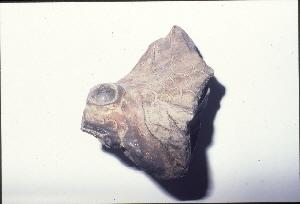
Found in the remains of Odaka Castle, this is a piece of sea bream painted with gold leaf and vermilion.
Pieces like this are said to often be excavated from the ruins of a daimyo castle under Toyotomi, and it can be claimed as a valuable object that points to the Soma clan's historical background.
26. Ikoma-ke Monjo (Ikoma Family Documents)
Type: City designated tangible cultural property (ancient document)
Date Designated: March 31st, 2002
Location: Odaka-ku, Izumisawa
Owner: Individual
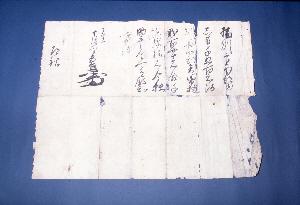
The Ikoma family originally served Hideyoshi Toyotomi, and later served in key positions in the Soma Nakamura domain such as chief retainers.
This ancient document is a rare handwritten document from the prefecture, written by Hideyoshi Toyotomi. In addition, there are letters sent to the Ikoma family from Toyotomi Hidetsugu and the Five Commissioners of Hideyoshi. These contains a lot of valuable information for learning the history of Soma, such as a traditional New Year’s card from the lord of Soma Nakamura.
27. Soma-ke Bochi Narabini Reido (Soma Clan Cemetery and Religious Hall)
Type: City designated historic site
Date Designated: March 31st, 1966
Location: Odaka-ku, Odaka, Kamihirohata
Google Maps: Dokeiji Temple
Owner: Individual
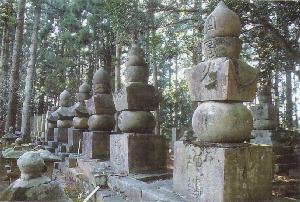
Dokeiji Temple is a Buddhist temple of the Soma clan, and generations of lords have been buried here throughout the Edo period. The Soma clan cemetery centered around the orderly gorintou (5-part gravestones representing earth, water, fire, wind, and heaven) and the sacred hall that houses the Buddhist mortuary tablets of the Soma family are designated by the city as tangible cultural property.
28. Namiiwa no Ouketsu Kofun A-Gun 11-Go (Namiiwa Tunnel Tomb Burial Mound, Group A No. 11)
Type: City designated historic site
Date Designated: March 31st, 1966
Location: Odaka-ku, Izumisawa, Namiiwa
Google Maps: Namiiwa Yokoana Kofun
Owner: Minamisoma City
Among the group of horizontal graves in Namiiwa, Izumisawa, some of Group A No. 11 have red and white coloring. They are decorative tunnel tombs similar to the nationally designated historic sites Kiyotosaku Yokoana (Futaba-cho) and Hayama Yokoana (Haramachi Ward), thought to have been originally filled with decorations on par with either yokoana. In addition, it is confirmed that people and cranes were engraved in the side of the graves of Namiiwa.
29. Murakami-jo Seki (Murakami Castle Ruins)
Type: City designated historic site
Date Designated: March 31st, 1966
Location: Odaka-ku, Murakami, Tateuchi
Google Maps: Murakami-jo Seki
Owner: Individual
The 16th head of the Soma clan Soma Yoshitsune built a strategically important embankment in this area overlooking the Pacific Ocean, and the day before the main hall was about to be built, the piled up wood burned in a fire and turned to ash. Taking this as an ominous sign, Yoshinori decided to build a castle at Ushigoe Castle (Haramachi Ward). The earthwork and moat still remain as a testament to what occurred at that time.
30. Shobuzawa no Nomadote・Takakido No Nomadote (Shobuzawa and Takakido Wild Horse Embankments)
Type: City designated historic site
Date Designated: March 31st, 1970
Location: Odaka-ku, Hanokura, Shobuzawa (+others)
Owner: Individual
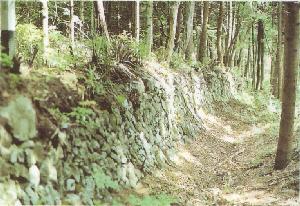
Stone walls and earthworks were built in the Edo period for the purpose of protecting and breeding wild horses as well as protecting agricultural products. Parts of the walls still remain, largely in wide areas of Haramachi, but several hundred meters are also left in Odaka, Hanokura.
31. Himuki Ouketsu Gun 1-Goba (Himuki Yokoana Group No. 1 Graves)
Type: City designated historic site
Date Designated: September 20th, 1982
Location: Odaka-ku, Tsukabara, Himuki
Owner: Individual
These graves are located in Tsukabara and are thought to be from the 6th century, around the time the Yokoana tombs were made in this region.
32. Iwayado Sekibutsu Narabini Ouketsu Bogun (Iwayado Stone Buddhas and Graves)
Type: City designated historic site
Date Designated: January 26th, 1994
Location: Odaka-ku, Yoshina, Urushibara
Owner: Individual
There are more than a dozen graves in Urushibara, Yoshina, but they were remodeled at a later time and the rocks were carved like the stone Buddhas of Daihisan. It is believed that the Yokoana tomb was from the Kofun period and the stone Buddhas were from the Heian period.
33. Namezu no Osugi (Namezu’s Giant Japanese Cedar)
Type: City designated natural monument
Date Designated: February 1st, 1968
Location: Odaka-ku, Namezu
Google Maps: Hoshi Shrine
Owner: Hoshi Shrine
Dimensions: Height – about 30m tall Circumference – 7m (at eye-level)
When heading south towards Namie on National Route 6, the giant Japanese cedar stands out on the right at approximately 30 meters high, measuring 7 meters around at eye-level. It is still considered a sacred and important tree of the Hoshi Shrine in Namezu.
34. Dokeiji no Ichou (Gingko of Dokeiji Temple)
Type: City designated natural monument
Date Designated: October 1st, 1975
Location: Odaka-ku, Odaka, Kamihirohata
Google Maps: Dokeiji Temple
Owner: Dokeiji Temple
Dimensions: Height – about 35m Circumference – 5.3m (at eye-level)
This is a giant ginkgo tree, which is rare in this region. It measures about 35 meters in height and 5.3 meters around at eye-level. It is estimated that the tree is 300 to 400 years old, and it can be said that the tree was cultivated alongside the development of the Dokeiji Temple.
35. Hanzaki no Shidare Sakura (Weeping Sakura of Hansaki)
Type: City designated natural monument
Date Designated: September 20th, 1982
Location: Odaka-ku, Hansaki, Kitakubo
Google Maps: Hanzaki no Shidare Sakura
Owner: Minamisoma City
Dimensions: Height – about 12m Circumference – 3.6m (at eye-level)

This is an old weeping cherry tree (Benishidare Sakura). It is located inside the Kitakubo Joint Cemetery in Hansaki. It is a large tree that measures approximately 12 meters in height and measures 3.6 meters around the trunk at eye-level. The branches are approximately 300 square meters, folding out in the shape of an umbrella. It is particularly lively and excellent in appearance. In spring it blooms beautifully like blanket over the graves.
36. Kamiura no Kyara (Kamiura Aloes)
Type: City designated natural monument
Date Designated: January 26th, 1994
Location: Odaka-ku, Kamiura, Enmeisaku
Owner: Individual
Dimensions: Height – about 2m Branch length – about 15m
Aloes is a yew genus of the Taxus family originating in high mountains, and is a shrub planted in gardens. The height is only about 2 meters, but the branches are about 15 meters long and fold out like an umbrella. It is estimated to be over 300 years old.
37. Otomi no Hiiragi (Otomi Holly)
Type: City designated natural monument
Date Designated: July 1st, 1997
Location: Odaka-ku, Otomi, Kumadaira
Owner: Individual
Dimensions: Height – about 9m Circumference – 2.7m (at eye-level)
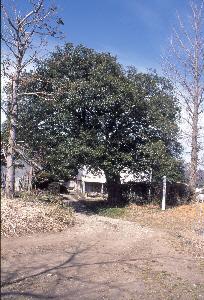
Measuring about 9 meters in height and about 2.7 meters around at eye-level, this tree is estimated to be over 100 years old. Holly grows naturally in the Iwaki region, where it grows in harsh environments, but this holly is a very rare, old tree full of vigor and with excellent branching.
- この記事に関するお問い合わせ先
- このページに関するアンケート
-
より良いウェブサイトにするために、このページのご感想をお聞かせください。















更新日:2021年05月19日